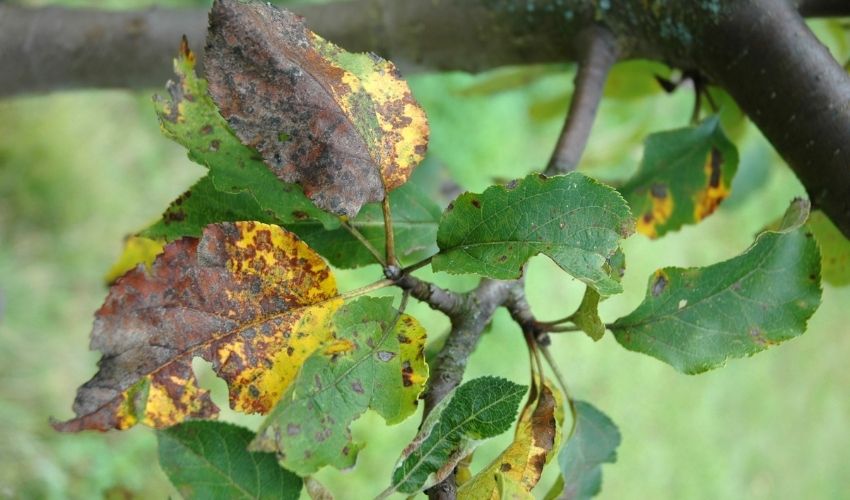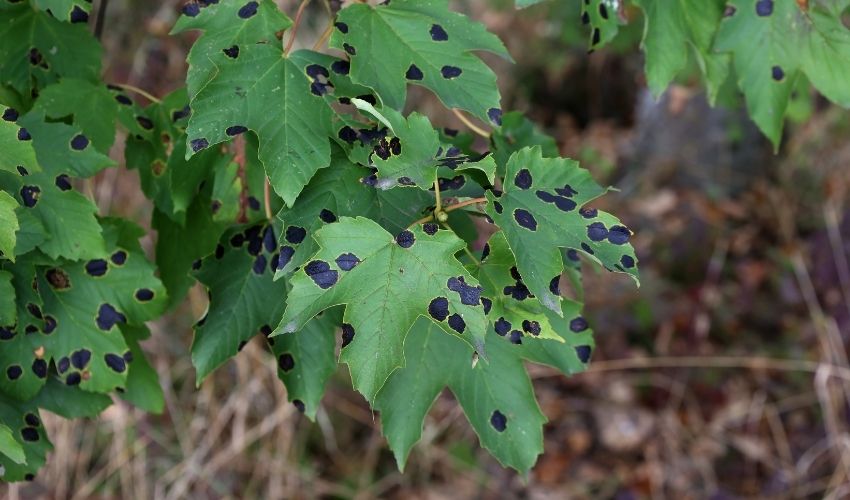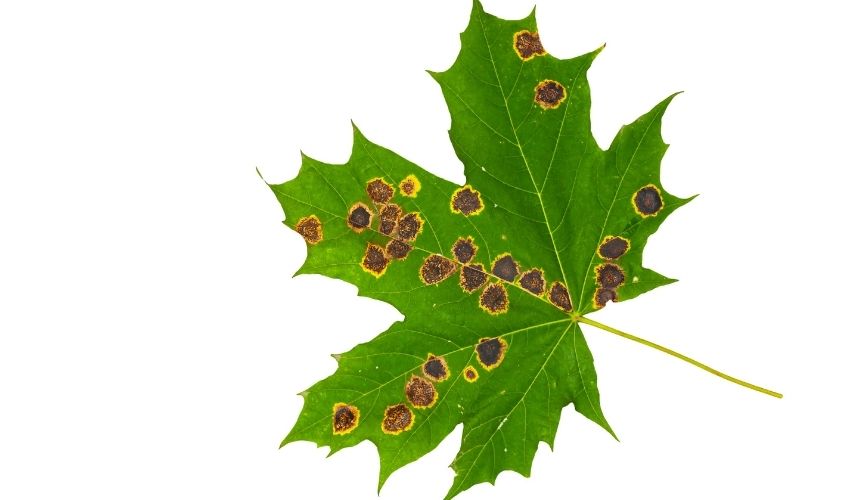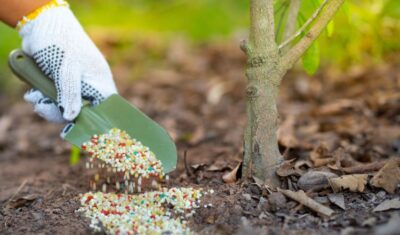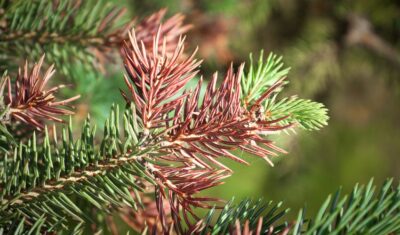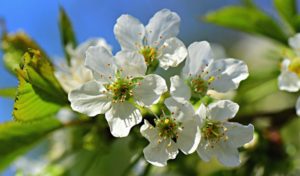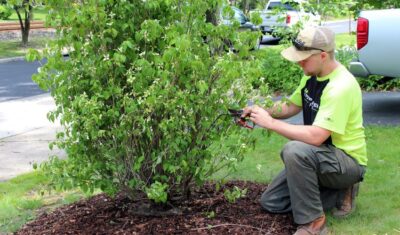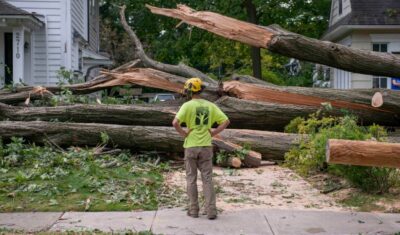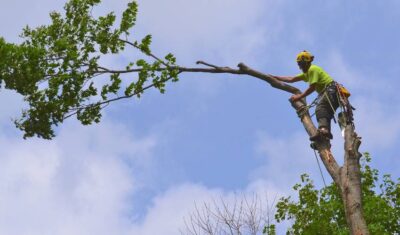Spots on tree leaves are a common summer problem in northeast Ohio. The leaf spots usually aren’t serious, but if they occur with other symptoms or conditions, then they may be cause for concern. By knowing what’s causing the spots and how to treat and prevent leaf spot problems, you’ll have a healthier tree that requires less maintenance in the long run.
Keep reading to learn:
- FAQs about spots on tree leaves,
- How to know whether the blemishes indicate an underlying disease, insect infestation, or other problem that will affect your tree’s health,
- Common leaf spot diseases in northeast Ohio, including a description of symptoms and severity of the problem,
- What to do when you notice spots on your tree’s leaves, and
- How to prevent long-term problems caused by leaf spots.
Questions About Leaf Spots on Trees
My tree has leaf spots. Is this bad?
The answer is: it depends.
Leaf spot disease is an umbrella term that covers many different diseases that affect foliage.
Leaf spot can be a bacterial or a fungal disease, though fungal leaf spot diseases are the most common.
Will leaf spots kill my tree?
It depends on the type of spots and what’s causing them.
Many spots on tree leaves are a cosmetic or aesthetic problem. However, some leaf spots are a result of fungal or bacterial diseases that can kill your trees over time. It’s important to know the difference.
The main danger to your trees is the loss of healthy leaves. A tree’s leaves are its energy source; they provide a tree with food energy through photosynthesis. If leaf spot disease kills so many leaves that your tree doesn’t have enough energy stores, your tree can decline or even die.
Do all trees get leaf spots?
Almost all trees can get leaf spot disease. In northeast Ohio, it’s most noticeable on broadleaf, deciduous trees such as:
- oaks,
- maples,
- horse chestnut, and
- sycamore.
We admire these trees for their green summer leaves and their fall color. Unfortunately, fungal and bacterial leaf diseases cause early leaf drop and reduce fall color displays.
When do spots usually show up on tree leaves?
Some types of leaf spot will appear regularly each year and some show up only during specific conditions such as:
- excessively rainy and humid weather,
- unseasonably cool temperatures, or
- high heat.
Why are there so many leaf spots on trees in summer?
Summer is the season when everything is growing, and this includes leaf diseases. Warm, rainy, and humid summer weather helps both bacterial and fungal diseases thrive. From there, it’s easy for them to spread to healthy trees and plants.
How do leaf spots spread to other trees?
Here are some of the common ways in which these diseases spread:
- Fungal diseases spread by spores, which are like microscopic seeds. Fungal fruiting bodies (the “spots” you see on leaves) release spores which are then dispersed to other leaves and plants.
- Spores can be spread by natural occurrences such as wind, rain, and hail.
- Disease symptoms, such oozing cankers, can also spread disease.
- People are also disease spreaders, infecting healthy plant tissue through infected tools, pruning cut wounds, and propagation and grafting cuts.
- Insects are often vectors (disease carriers), as they transfer diseases while they feed on tree leaves or chew through bark.
How do know if my tree has leaf spot disease or something else?
Some leaf diseases are easy to recognize – think of rust spot, which looks just like its name suggests.
But it can be hard to identify diseases if you’re not familiar with them.
Here are some general guidelines to help you tell leaf spot diseases from other conditions.
- Leaf Spot Diseases – You’ll always find individual leaf spot diseases scattered around the leaf. Whatever their shape, you’ll find them on all parts of a leaf’s surface.
- Damage from Cultural Practices – Overwatering, drought, or fertilizer burn can all damage leaves. However, these will make entire areas on the tips and margins of leaves turn yellow or brown, rather than spreading spots across the leaf surface.
- Environmental Damage – Hail and strong wind can put holes or puncture wounds in leaves, sometimes making leaves look like they’re spotted. This cosmetic damage is usually accompanied by torn and tattered leaves, and you’re unlikely to forget the kind of weather event that caused the damage!
- Insect Damage – There are many sap-sucking insects whose feeding results in leaf spots. However, these spots tend to be much smaller (such as the stippling effect caused by aphid feeding) and are almost always yellow or whitish.
What’s the difference between bacterial and fungal leaf spot diseases?
Most bacterial leaf spot diseases form a yellow edge or “halo” around infected areas of a leaf. The interior of the spot may be tan, brown, or black, but will always have a yellow border.
These yellow margins are less common in fungal leaf spots but do appear with some. Fungal leaf disease is more easily identified by the spores that develop within the leaf spot.
Common Leaf Spot Diseases Affecting Northeast Ohio Trees
Below are the leaf spot diseases we most often see in northeast Ohio, as well as the symptoms or signs that can help you identify what’s affecting your tree’s leaves. Toward the end we also describe two common leaf diseases that look more like blotches, rather than spots; anthracnose and guignardia leaf blotch.
Maple Tar Spot
This fungal disease looks like its name suggests: round, black spots on your maple tree leaves. It’s caused by two pathogens, Rhytisma acerinum and Rhytisma punctatum. As the disease grows, the black spots become raised, and yellow margins surround them. While this disease may look alarming, it is cosmetic and no treatment is needed.
>> Learn more about maple tar spot
Maple Leaf Spot
Although the names are similar, a different fungus (Phyllosticta minima) causes this maple leaf disease. It forms light brown circles or irregularly shaped areas that have dark outlines. Like maple tar spot, this leaf disease is not fatal and doesn’t do much damage to trees, although it can be very visible in the landscape, especially on silver and red maples.
Powdery Mildew
This fungal leaf disease looks like its name: young leaves show small circles of white or gray powdery fungus on both their top and bottom sides. These spots enlarge and merge, and leaves twist and distort before turning brown.
Frogeye Spot on Crabapples
This fungal leafspot disease (caused by Botryosphaeria obtuse) affects crabapple leaves during moist spring weather. You’ll notice small roundish brown spots with purple borders, sometimes with dark pimple-like fruiting bodies inside the spot. Over time, some of the borders enlarge to create larger spots that look a bit like a frog eye. On susceptible crabapple cultivars, frogeye spot can also cause defoliation and black rot cankers on stems. However, for most trees it is only a minor problem that doesn’t need preventive treatment.
Cercospora Leaf Spot
This disease affects many trees, including buckeye, elm, oak, and locusts.
Cercospora leaf spots are round, and start out purple or dark red. As they spread the center will turn gray or brown, but the margin stays dark. The dead centers of these leaf spots may fall out and leaves will look peppered with holes.
Cedar-Apple (or Cedar-Hawthorn) Rust
Cedar-apple rust, caused by the fungus Gymnosporangium juniperi-virginianae, is widespread throughout northeast Ohio. In early summer, you’ll start to notice pale yellow spots on apple (or hawthorn) leaves. Over time, the spots get larger and turn a bright yellow-orange color that’s visible on both the upper and lower leaf surfaces. Eventually, small black dots (fungal bodies) appear within the spots and leaves may fall off. In most cases, cedar-apple rust doesn’t need preventive treatment; good cultural and sanitation practices usually do the trick.
Unlike other leaf spot diseases, this one needs two different host trees to complete its lifecycle: an apple, crabapple or other related members of the Rose family and a tree in the Juniperus species, such as eastern red cedars and junipers.
Apple Scab
This fungal disease, caused by the fungus Venturia inaequalis, appears in early spring and spreads quickly among apple and crabapple trees. It starts with light brown circular spots on leaves and fruit, which then darken and sink into the tissue surface (looking like scabs). Fungal spores often appear in the scabs as the leaves become deformed and fruit drop prematurely. Unlike some other leaf spot problems, apple scab is a serious disease that needs to be treated with preventive fungicide applications in spring.
>> Learn more about apple scab
Anthracnose
Anthracnose is an annual fungal leaf disease caused by the fungus Colletotrichum lagenarium. It kills early spring leaves, as the pathogen prefers cool, wet weather. Irregular areas of brown can be seen along the central leaf veins, small dead spots appear, and eventually the entire leaf shrivels and dies. Leaves that appear in late spring and summer are rarely infected, as the weather is hotter and drier.
Anthracnose affects a wide range of deciduous trees, including sycamore, dogwood, maple, oak, and other hardwoods.
Guignardia Leaf Blotch on Horse Chestnut
This fungal disease causes serious cosmetic damage to the leaves of our state tree in late summer, although it doesn’t seem to be a serious health problem. Leaves develop irregularly shaped areas of red-brown diseased tissue. The disease (caused by Guignardia aesculi) will spread to the tips and edges of leaves until the leaves look scorched and twisted. The cosmetic leaf damage can be prevented with fungicide sprays applied in early spring.
Managing Spots on Tree Leaves
Will leaf spots go away on their own?
No. Once a leaf is infected and damaged by leaf spot diseases, it will not recover or turn green again. The diseases kill the parts of the leaf they grow on.
For deciduous trees this is not usually a problem, as these trees put out new leaves each spring. If a tree has enough leaves to produce food energy to carry them through winter, they will survive.
Leaf spot diseases won’t disappear on their own, but they may not appear each year. Diseases that need certain conditions (rain, cool temperatures, heat) won’t develop if conditions aren’t right.
You will want to find out what leaf spot disease you tree has, because some are more damaging than others. Depending on the disease, repeated infections can weaken your tree so much that it won’t survive.
A certified arborist can identify your leaf spot disease and offer solutions. It’s important to understand that there may not be a real treatment and preventive care may be your only choice.
How can I prevent long-term problems caused by leaf spots?
Keep Your Trees Healthy
The most effective way to reduce leaf spot diseases is to keep your trees and your whole garden healthy. You’ll find some helpful information about how to do that in our article on Integrated Pest Management.
Healthy trees are better able to withstand diseases and more likely to put out new leaves after they’ve dropped diseased ones. And having sufficient water and nutrients available ensures your tree will continue growing despite the stress caused by leaf spots.
Water the Right Way
If you water your garden in the evening, you may be creating conditions for fungal diseases to thrive and spread. And cool evenings and wet foliage also attract slugs and snails, which nobody wants in their garden!
It’s always a good idea to water early in the morning. This ensures that any excess water that’s left on leaves, branches, or the soil surface will evaporate during the day.
Clean Up Well
Another important thing to do is rake up and discard fallen twigs, branches, and dead leaves as soon as they fall. Just because the leaves are dead, doesn’t mean that the fungus is also dead.
Infected branches and leaves can spread both fungi and bacteria and create places for fungal spores to overwinter.
And remember to discard the infected material; if you rake leaves into a pile and leave them in your garden, wind and rain will carry spores back to your trees.
Plant Disease-Resistant Trees & Shrubs
Prevention is always better than a cure! While you may not be able to eliminate unsightly leaf spots altogether, you can minimize infections by planting species and cultivars with good genetic resistance to common diseases. For example, there are many excellent apple and crabapple varieties that have good resistance to apple scab.
Apply Preventive Treatments
Many leaf spot diseases cause only cosmetic damage and don’t need treatment. But some, such as apple scab, are serious enough to warrant preventive treatment with a fungicide.
Consult a Certified Arborist to properly diagnose any tree leaf issues before spraying trees yourself. If you’ve misidentified the cause of the leaf spots, your treatment is likely to do more harm than good. It’s usually best to let an arborist apply the necessary treatment; that way, you know that the right treatment will be used and that it will be applied properly and at the right time (timing is critical).
We Can Help
Not sure if the spots you’re seeing on your tree’s leaves are something serious or just cosmetic? Have our Certified Arborists evaluate your trees, diagnose the issue, and recommend whether treatment is needed. And if you want to make sure your trees and your garden stay at their best, ask us about our comprehensive Plant Health Care programs.
Schedule a Property Inspection
Contact Independent Tree to schedule a tree and property inspection, where we can evaluate the health of your trees and inform you if any treatments or care are needed.Recent Articles
Topics
About The Author

STAY IN THE LOOP
WITH OUR
LATEST UPDATES
"*" indicates required fields

